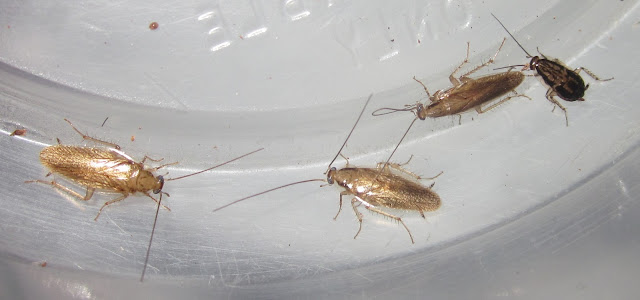Here are the last of the new additions to my collection that I got from Brandon Maines just a few weeks ago. 😃
First off, he sent me a mated adult female and three nymphs of Arenivaga sp. "Phoenix, AZ". These were sold to him as Arenivaga tonkawa years ago, however they were clearly misidentified, and are more likely erratica IMO (but I'll need to see a mature male in person to come to a tentative ID).
I have them set up in the typical Arenivaga fashion, a very well ventilated container with an inch of coconut fiber substrate, one third of which I'm keeping humid, the rest bone dry. On top of the substrate there's some leaf litter for them to nibble on, and I'm also offering dog food for protein. Keeping them at around 75F°.
Here are some pictures of the adult female:
Such a vibrant red color, and she's already laid a few ooths for me, so will likely have hatchlings in a matter of months!
Next up, he sent me a group of Neoblattella sp. "Miami", an unidentified and potentially undescribed species collected by Alan Jeon last year. They highly resemble N.detersa, however the pronotum markings are different on adults, and adult female sp. "Miami" have pretty short wings, compared to the fully winged females of detersa.
I have them set up in a well ventilated deli cup with a thin layer of coconut fiber substrate, with some leaf litter, paper towels and bark for hides. I'm keeping them humid and at 75-80F°, and am feeding them dog food and fruits.
Here are some pictures of them:
 |
| Adult males |
 |
| Adult males and nymph |
 |
| Adult female |
 |
| Nymphs |
A neat little species for sure, the adult females look pretty cute with their short wings and squat appearance.
Next up, a familiar face for me, but not one I've ever bred before or posted about on the blog, the Flathorn Hisser, Aeluropoda insignis. Perhaps one of the most unique hissers in terms of morphology in the hobby, with very nice red and black coloration. They are sadly quite underrated, despite being easy to culture, and true major males being able to reach a very large size.
I've got them set up in a well ventilated container with an inch of coconut fiber substrate, with bark and cardboard rolls for hides. I'm keeping a third of the enclosure humid, the rest bone dry, and they're being kept at 75F°. For food I'm offering dog food and fruits.
Here are some pics of an adult pair:
 |
| Male |
 |
| Female |
Definitely an underrated species, hopefully they'll thrive for me! 😄
Lastly, he sent me some European Orange springtails, Yuukianura aphoruroides (previously erroneously identified as Bilobella braunerae and Protanura sp. "Orange"). I've been wary of getting these previously, since my more prolific springtails and predatory mites usually get into slower breeding springtail bins and wipe them out... however apparently these are pretty hardly little dudes, and Brandon has tons of them now, so why not try right?
I've got them set up in a moderately ventilated container with a mix of flake soil, coco fiber, moss, and a tiny bit of sand as the substrate, almost an inch deep. I'm keeping them humid,, and at around 74F°. Feeding them dog food and artificial pollen. Pretty sure they're already breeding, so that's a good sign I suppose.
Here are some pictures of the little living cheeto dust:
A cute species for sure, wish I'd been able to get some better pictures of them. 😅 Hopefully they'll breed well for me!
Well, that does it for this post, thanks for reading, hope everyone enjoyed, and I'll see you all next time! 😉
























































No comments:
Post a Comment